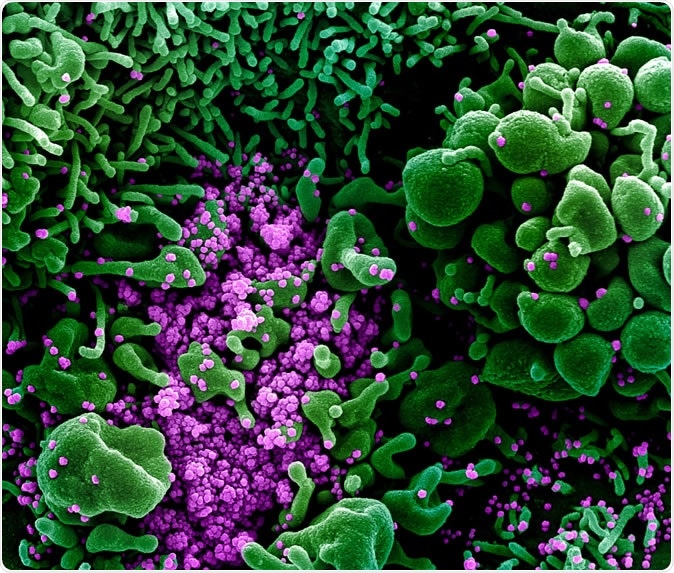
Novel Coronavirus SARS-CoV-2 Colorized scanning electron micrograph of an apoptotic cell (green) heavily infected with SARS-COV-2 virus particles (purple), isolated from a patient sample. Image captured and color-enhanced at the NIAID Integrated Research Facility (IRF) in Fort Detrick, Maryland. Credit: NIAID
SARS-CoV-2 has recently emerged as a human pathogen and already led to a worldwide pandemic of coronavirus disease 2019 (COVID-19) that has caused almost 300 thousand deaths worldwide (as of May 13, 2020). Since currently, there are no vaccines or approved treatments, novel therapeutic approaches are desperately needed.
While most of its genome is more than 80 percent similar to the original SARS coronavirus (SARS-CoV), there are regions with substantially lower amino acid conservation. And although the divergence in spike glycoprotein and several accessory proteins was expected, some non-structural proteins also show disparities from the original SARS virus and Middle East respiratory syndrome coronavirus (MERS-CoV), which could, in turn, affect the biology of SARS-CoV-2.
The importance of highly conserved macrodomain
The genome of all coronaviruses contains a code for a highly conserved macrodomain 1 (Mac1) within the non-structural protein 3 (nsp3). This microdomain binds to and removes ADP-ribose from proteins (also known as ADP-ribosylation), which is otherwise added after the translation process, i.e., when proteins are made from a genetic information template of the virus.
This protein domain is actually pivotal for coronavirus pathogenesis; more specifically, Mac1 likely opposes host-mediated antiviral ADP-ribosylation that acts as a part of the host response to viral infections.
The functional importance and disease-causing ability of Mac1 have been previously demonstrated in several research reports, which makes it an ideal candidate for further drug development – primarily based on its biochemical activities within the coronaviruses, as well as its highly conserved structure.
However, understanding its exact biochemistry and enzyme activity are key initial steps before any actual therapeutic considerations. Consequently, a research group from several laboratories at the University of Kansas in Lawrence (Kansas) decided to elucidate this research problem
The universal weapon of coronaviruses
These scientists refined and verified the crystal structure of SARS-CoV-2 Mac1 (in complex with ADP-ribose) at 2.2‐Angstrom resolution. Knowing that one Angstrom accounts for about a billionth of a meter, we can be certain that we now have ample structural information to assist in any drug development efforts.
After observing structural and functional similarities in detail between viral macrodomains, the researchers then hypothesized that SARS-CoV-2 Mac1 has similar binding and hydrolytic activity as other coronavirus Mac1 enzymes.
And indeed, it was shown that Mac1 of SARS-CoV-2, SARS-CoV, and MERS-CoV share similar structural folds and ADP-ribose binding modes. In addition, all three coronavirus Mac1 proteins bind to ADP-ribose with low micromolar affinities.
The role of Mac1 in replication and pathogenesis of coronaviral infection was thus far primarily appraised by discerning the mutation of a highly conserved amino acid asparagine to amino acid alanine. Albeit this particular mutation has minimal effects on viral replication in transformed cells, it reduces viral load, leads to the augmented interferon response, and firmly attenuates SARS-CoV in a mouse model of infection.
Potentially broad antiviral activity
This research showed that Mac1 proteins of SARS-CoV-2 and other coronaviruses are highly efficient ADP-ribosylhydrolases with strikingly similar activity, suggesting that compounds targeting coronavirus Mac1 proteins may exert broad antiviral activity against this viral group.
But this may also have implications for regulating interferons, which are cytokines recruited as a response to viral infections. "Targeting Mac1 may also have the benefit of enhancing the innate immune response, as we have shown that Mac1 is required for some coronaviruses to block interferon production", explain study authors.
This paper also revealed certain methodological improvements. While previous studies of macrodomain de-ADP-ribosylation utilized radiolabeled substrate, this research group obtained reproducible and robust data by using a panel of monoclonal antibodies designed to specifically recognize mono-ADP-ribose.
"The use of these antibodies should enhance the feasibility of this assay for many labs that are not equipped for radioactive work," say study authors on improving future research endeavors on this topic.
Future research directions
"Future studies could utilize the SARS-CoV-2 Mac1 structure to identify the mechanisms it uses to bind to its biologically relevant protein substrates, remove ADP-ribose from these proteins, and potentially define the precise function for Mac1 in CoV replication and pathogenesis", emphasize study researchers.
And indeed, such research will be crucial for designing and developing highly-specific Mac1 inhibitors for eventual therapeutic use in order to mitigate current COVID-19 pandemic, but also any other potential future coronavirus outbreaks.

 This news article was a review of a preliminary scientific report that had not undergone peer-review at the time of publication. Since its initial publication, the scientific report has now been peer reviewed and accepted for publication in a Scientific Journal. Links to the preliminary and peer-reviewed reports are available in the Sources section at the bottom of this article. View Sources
This news article was a review of a preliminary scientific report that had not undergone peer-review at the time of publication. Since its initial publication, the scientific report has now been peer reviewed and accepted for publication in a Scientific Journal. Links to the preliminary and peer-reviewed reports are available in the Sources section at the bottom of this article. View Sources
Journal references:
- Preliminary scientific report.
Yousef, M.O., et al. (2020). The SARS-CoV-2 conserved macrodomain is a highly efficient 1 ADP-ribosylhydrolase enzyme. bioRxiv. https://doi.org/10.1101/2020.05.11.089375
- Peer reviewed and published scientific report.
Alhammad, Yousef M. O., Maithri M. Kashipathy, Anuradha Roy, Jean-Philippe Gagné, Peter McDonald, Philip Gao, Louis Nonfoux, et al. 2021. “The SARS-CoV-2 Conserved Macrodomain Is a Mono-ADP-Ribosylhydrolase.” Journal of Virology 95 (3). https://doi.org/10.1128/JVI.01969-20. https://journals.asm.org/doi/10.1128/JVI.01969-20.